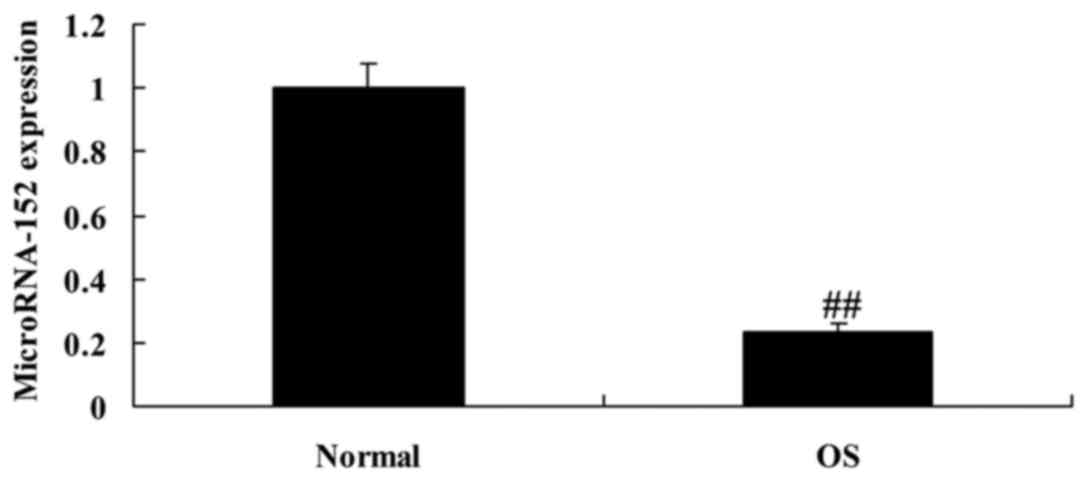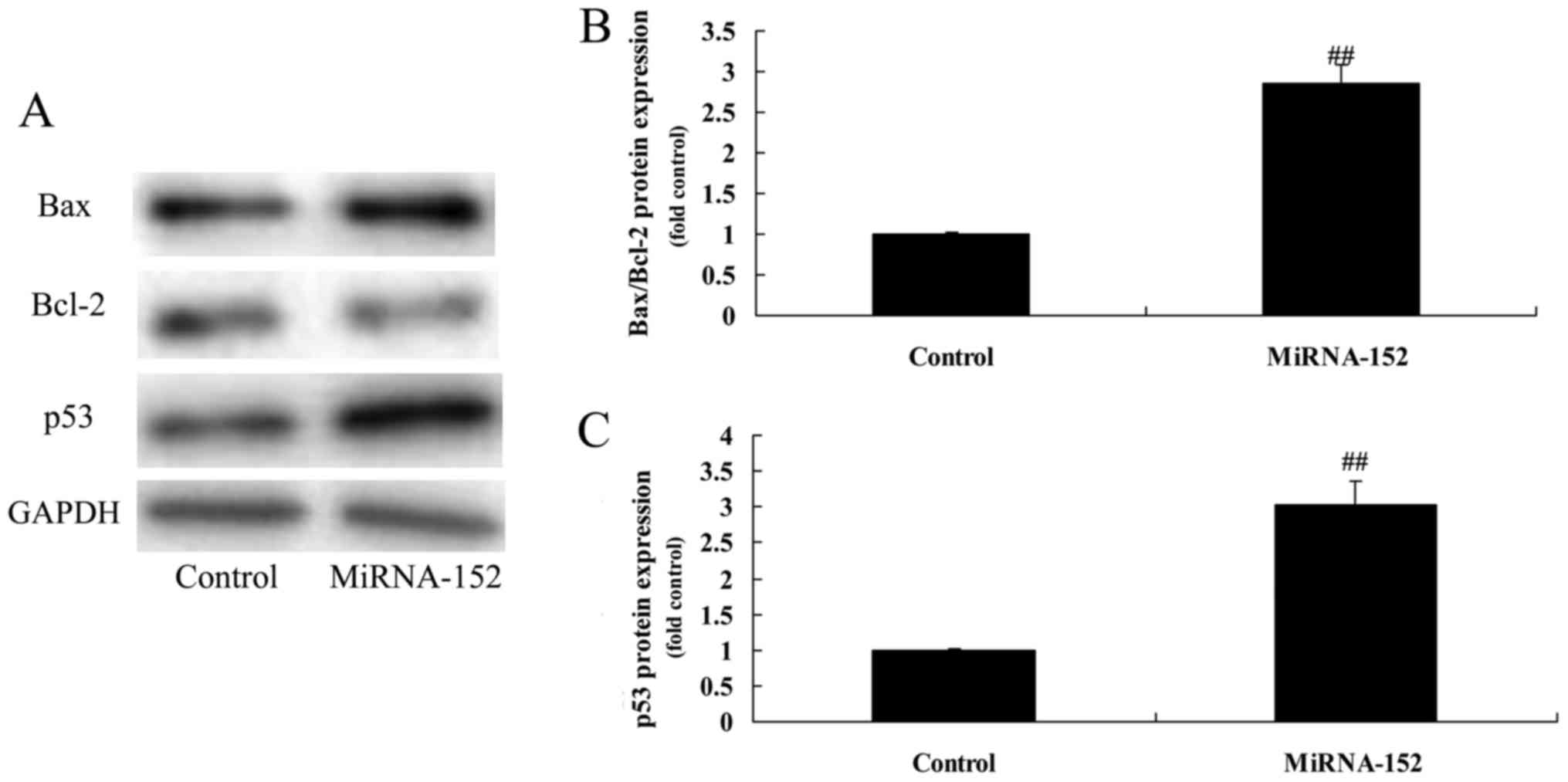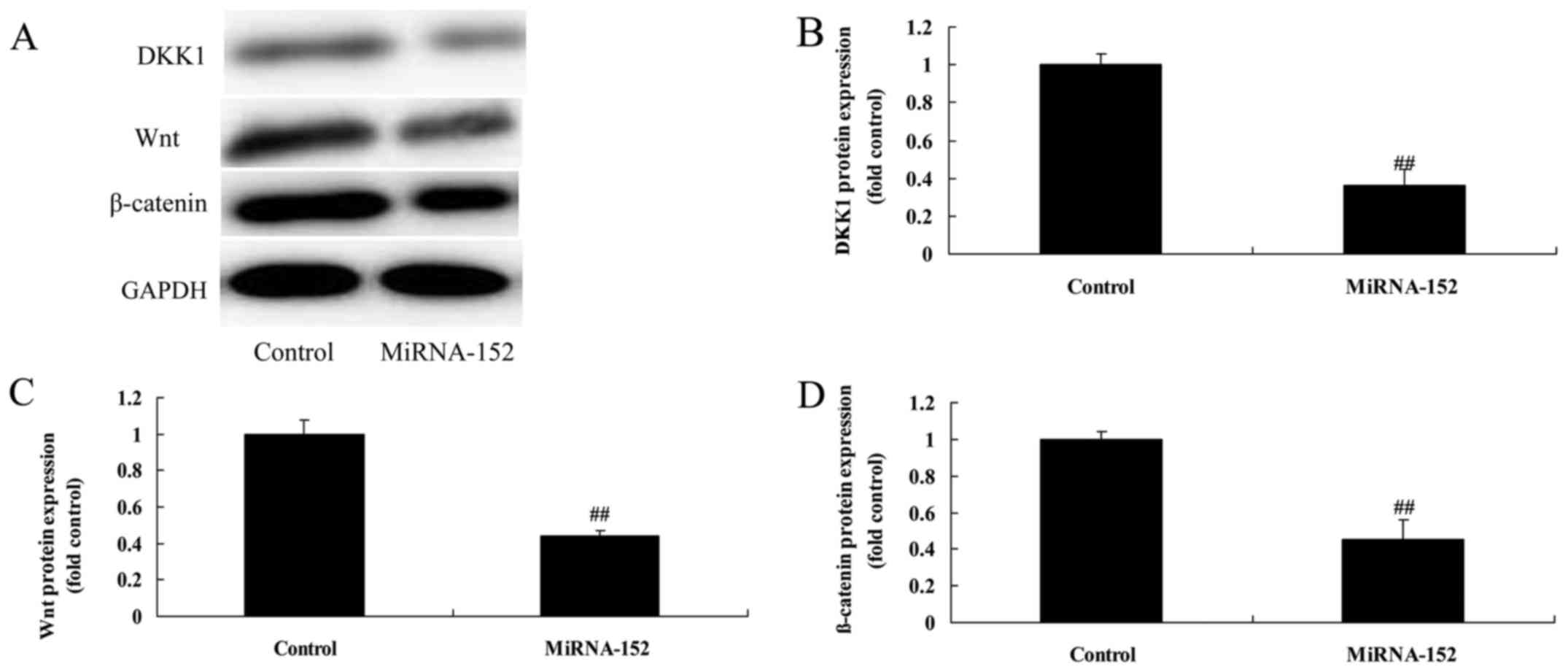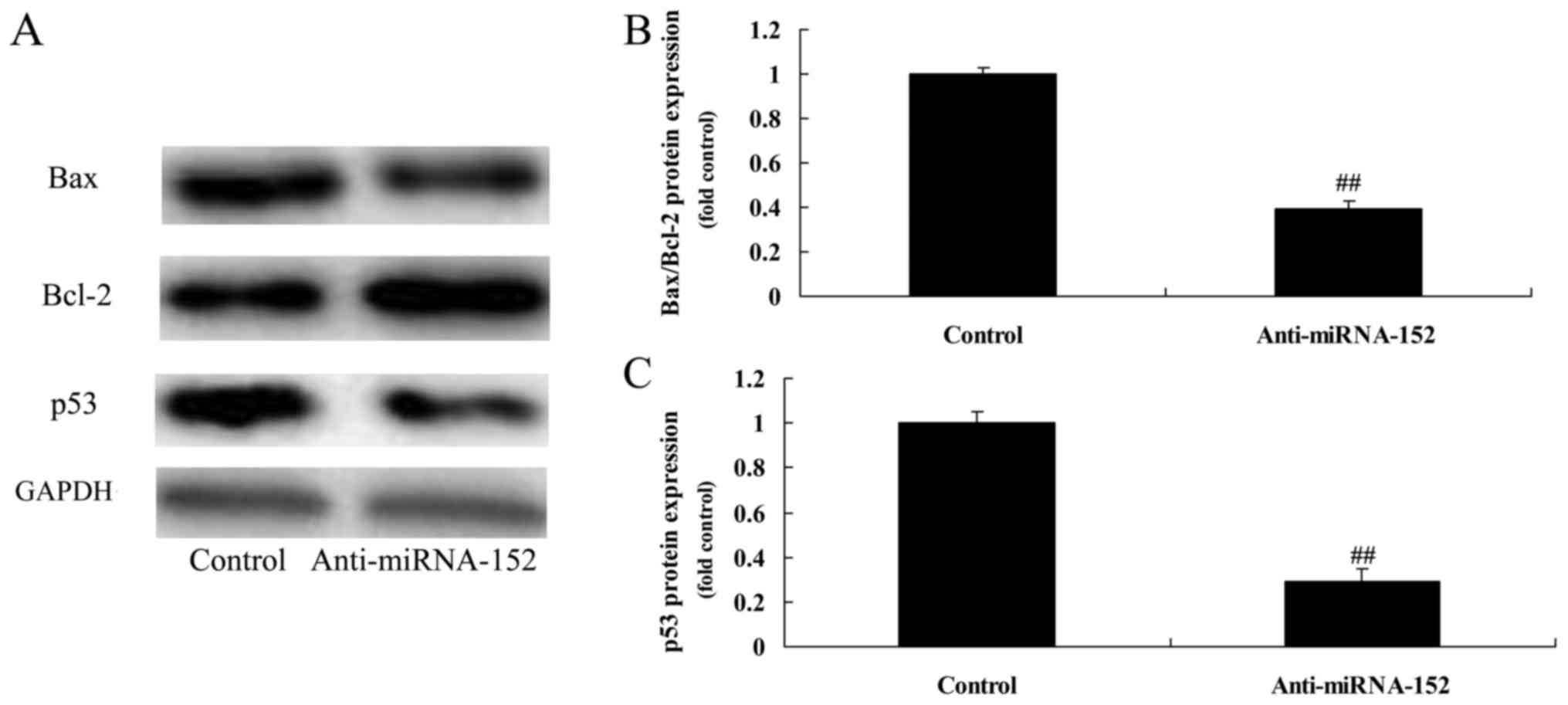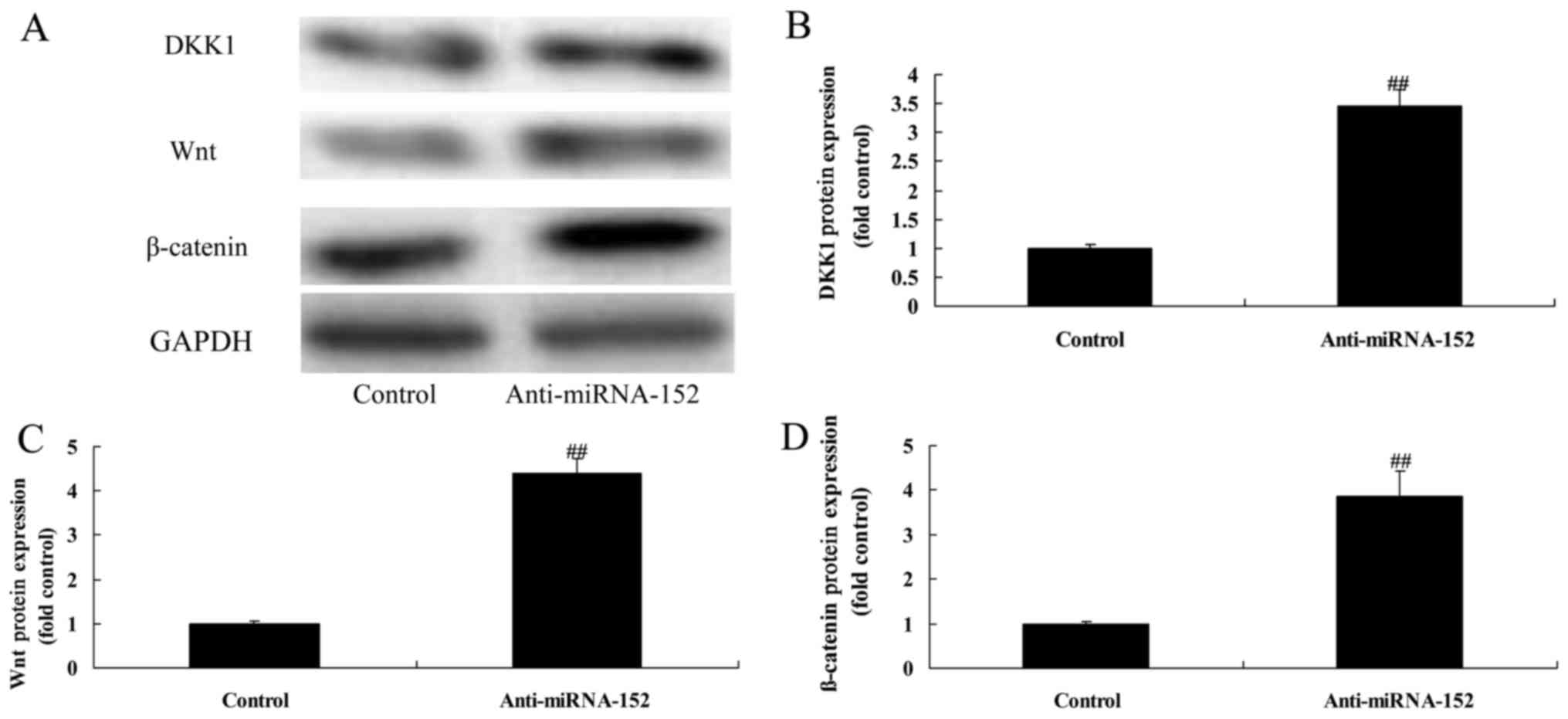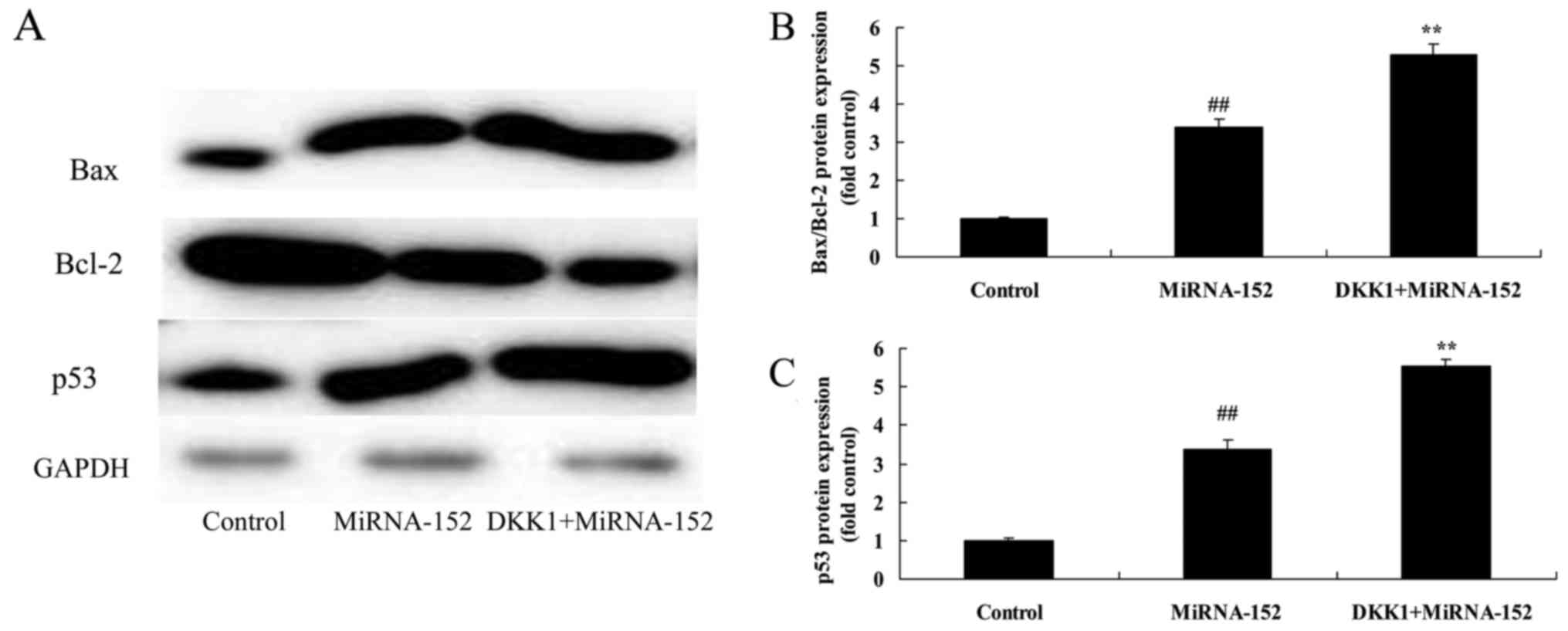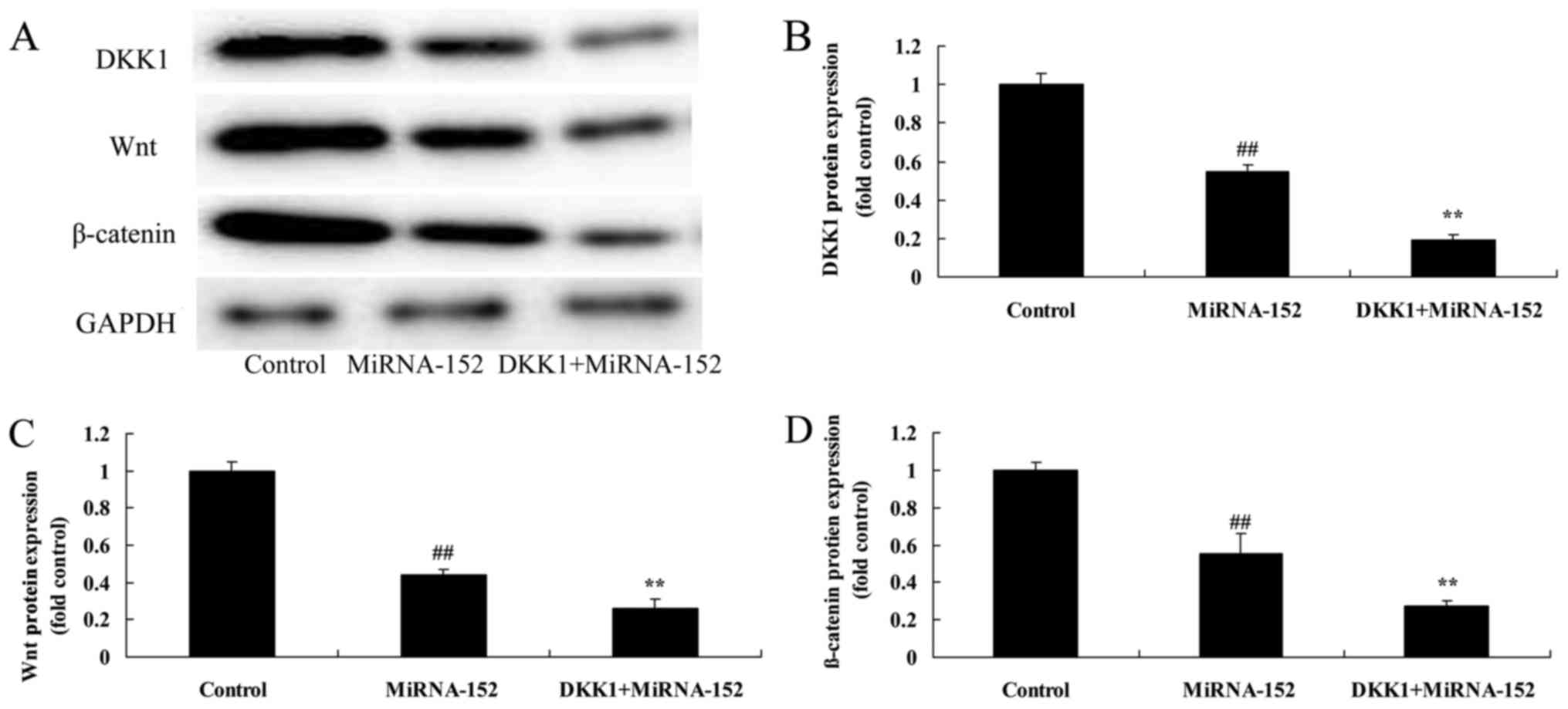MicroRNA-152 inhibits cell proliferation of osteosarcoma by directly targeting Wnt/β-catenin signaling pathway in a DKK1-dependent manner
- Authors:
- Published online on: May 22, 2018 https://doi.org/10.3892/or.2018.6456
- Pages: 767-774
Abstract
Introduction
Osteosarcoma (OS) is a primary marrow cavity solid tumor with high malignant degree, the morbidity of which ranks in the second place among all primary bone tumors, second only second to plasma cell myeloma (1). OS develops from mesenchymal cell lines, which is characterized by the production of osteoid tissue of fusiform stromal cells, as well as the osteoid tissue or immature bone produced by tumor cells (2). OS is the most common primary malignant bone tumor in clinic, which frequently occurs in children and adolescent (3). OS accounts for approximately 30% of malignant bone tumors and 3–4% of all tumors in children; in addition, it is associated with poor prognosis and low 5-year survival rate. With the increasing deepening of understanding towards tumor genesis and development, as well as the rapid development of treatment technologies such as surgical technique, imaging diagnostics, adjuvant chemotherapy and radiotherapy, especially the rapid development of individualized treatment, cell therapy, monoclonal therapy and tumor vaccine therapy, the 5-year survival rate of patients has increased from 10–20% to 50–70% by adopting the comprehensive treatment mode of neoadjuvant therapy with limb-sparing radical surgery, which has become the successful model in tumor treatment field (3,4).
Research on miRNA in recent years has been transferred from lower biological regulation like nematode to all physiological processes of mammals (5). Research concerning correlation of tumor with miRNA expression is extremely active, which facilitates the identification of multiple miRNAs that exert important regulatory effects in tumor progression (6). Currently, a part of miRNA profiles have been applied in tumor screening and metastasis as tumor markers (6). Transgenic mice with over-expression and deletion of specific miRNAs have also been extensively applied in investigating the roles of miRNAs in multiple malignant tumors. The present study provided experimental evidence for the function of microRNA-152 for a cohort of patients with osteosarcoma and the influence on cell growth of osteosarcoma.
Materials and methods
Ethics statement, patients, and samples
We collected serum of OS patients and normal volunteers at The Second Hospital of Jilin University, (Changchun, China). This study was approved by the ethics committees on The Second Hospital of Jilin University.
Total RNA was extracted from serum using the QIAzol lysis reagent and miRNeasy kit following the protocol of the manufacturer (Qiagen Inc., Valencia, CA, USA). Total RNA (200 ng) was used to compound cDNA synthesis using the QuantiTect Reverse Transcription kit (Qiagen Inc.). The real-time PCR (qPCR) was detected using SYBR Green Mix (Life Technologies). The PCR amplification conditions were as follows: 5 min at 94°C, for 40 cycles at 95°C for 30 sec and at 60°C for 30 sec.
Cell cultures and transfection
Human Osteosarcoma F5M2 cell line was acquired from the American Type Culture Collection (Manassas, VA, USA) and was cultured with RPMI-1640 medium (Gibco Life Technologies, Gaitherburg, MD, USA), 10% fetal bovine serum (FBS, Gibco Life Technologies) and penicillin (100 U/ml)/streptomycin (100 µg/ml) in a humidified atmosphere with 5% CO2 at 37°C. MicroRNA-152, anti-microRNA-152, si-DKK1 and negative control mimics were acquired from Sangon (Shanghai, China). Cell were transfected by using Lipofectamine 2000 (Gibco Life Technologies) according to the manufacturer's instructions.
Cell proliferation and flow cytometry based cell apoptosis assay
After transfection, cells were seeded onto 96-well plates and treated with methylthiazolyldiphenyl-tetrazolium bromide (MTT) assay (Sigma-Aldrich, St. Louis, MO, USA) for 4 h at 37°C. DMSO was added into cells and shaked for 20 min. The absorbance was determined on a microplate spectrophoto-meter (SpectraMax, Molecular Devices, Sunnyvale, CA, USA) at 490 nm.
After transfection, cells were seeded onto 6-well plates and stained with Annexin V-FITC/PI Apoptosis Assay (BD Biosciences Pharmingen, San Diego, CA, USA) for 20 min in the dark at 4°C. Apoptotic cells were recorded by applying CellQuest Software (BD Biosciences Pharmingen).
Caspase-9/3 activation
Cell protein was extracted using RIPA buffer containing protease inhibitors and phosphatase inhibitors. Caspase-3/9 activities was analyzed by caspase-3 and caspase-9 activity kits. The absorbance was determined using a microplate spectrophotometer (SpectraMax, Molecular Devices) at 405 nm.
Western blotting
Cell protein was extracted using RIPA buffer containing protease inhibitors and phosphatase inhibitors. Total protein (30 µg) were separated by 8–10% SDS-polyacrylamide gel electrophoresis (SDS-PAGE) and transferred to PVDF membranes (Millipore). Then, membranes were blocked with 5% bovine serum albumin (BSA), and incubated with Bax, Bcl-2, p53, Wnt, β-catenin, DKK1 and GAPDH (all, Cell Signaling Technology) at 4°C overnight. Membranes were incubated with HRP secondary antibodies (Cell Signaling Technology) for 1 h at 37°C. The protein expression was analyzed by the ChemiDoc XRS imaging system (Bio-Rad, Hercules, CA, USA) with Quantity One Program (version 4.6, Bio-Rad).
Statistical analysis
Data are presented as the mean ± standard deviation (SD). ANOVA (one-way analysis of variance) was used to determine the difference between or among groups. P<0.05 was considered statistically significant.
Results
The expression of microRNA-152 in OS patients
We validated the expression of microRNA-152 in OS patients using real-time PCR (qPCR). Fig. 1 showed that the expression of microRNA-152 was downregulated in patients with osteosarcoma. These results indicate that microRNA-152 may regulate osteosarcoma occurrence.
Overexpression of microRNA-152 inhibits cell proliferation and increases LDH activity
To establish a functional relationship between microRNA-152 and cell proliferation of osteosarcoma, osteosarcoma cells were transfected using microRNA-152 mimics. As shown in Fig. 2, overexpression of microRNA-152 inhibited cell proliferation and increased LDH activity of osteosarcoma.
Overexpression of microRNA-152 increases caspase-3/9 activity and apoptosis
Further, we investigated whether microRNA-152 regulates apoptosis of osteosarcoma. Fig. 3A and B, indicate that overexpression of microRNA-152 significantly decrease caspase-3/9 activities and apoptosis of osteosarcoma. Whereas, the results of DAPI staining showed that overexpression of microRNA-152 remarkably promoted cell nucleus apoptosis of osteosarcoma (Fig. 3C).
Overexpression of microRNA-152 increases Bax/Bcl-2 and p53 protein expression levels
As showed in Fig. 4, overexpression of microRNA-152 significantly induced Bax/Bcl-2 and p53 protein expression levels of osteosarcoma, which showed that microRNA-152 may adjust Bax/Bcl-2 and p53 protein expression levels to promote apoptosis of osteosarcoma.
Overexpression of microRNA-152 suppresses DKK1 and decreases Wnt/β-catenin
To further investigate the correlation between microRNA-152 and DKK1/Wnt/β-catenin signaling pathway, western blotting was used to compare the DKK1 protein expression after overexpression of microRNA-152. Our data suggest that overexpression of microRNA-152 significantly suppressed DKK1 protein expression, and induced Wnt and β-catenin protein expression in osteosarcoma (Fig. 5).
Downregulation of microRNA-152 expression promotes cell proliferation and decreases LDH activity
We determined whether the reversal of cell proliferation of osteosarcoma was adjusted by downregulation of microRNA-152 expression. As shown in Fig. 6, downregulation of microRNA-152 expression significantly promoted cell proliferation and decreased LDH activity of osteosarcoma.
Downregulation of microRNA-152 expression decreases caspase-3/9 activity and apoptosis
In order to investigate more detailed apoptotic mechanisms of microRNA-152 in osteosarcoma, the caspase-3/9 activity and apoptosis of osteosarcoma cells by microRNA-152 downregulation were measured. As expected, downregulation of microRNA-152 expression significantly decreased caspase-3/9 activity and apoptosis, and inhibited cell nucleus apoptosis of osteosarcoma (Fig. 7).
Downregulation of microRNA-152 expression decreases Bax/Bcl-2 and p53 protein expression levels
As shown in Fig. 8, downregulation of microRNA-152 expression significantly decreased Bax/Bcl-2 and p53 protein expression levels of osteosarcoma, which showed that microRNA-152 downregulation also adjusts cell growth of osteosarcoma.
Downregulation of microRNA-152 expression induces DKK1 and increases Wnt/β-catenin
We determined if microRNA-152 downregulation regulated DKK1/Wnt/β-catenin signaling pathway. Downregulation of microRNA-152 expression significantly decreased DKK1 protein expression and increased Wnt/β-catenin protein expression of osteosarcoma (Fig. 9). Taken together, these data suggested microRNA-152 could be a potential regulator for Wnt/β-catenin protein expression via targeting DKK1.
The inhibition of DKK1 promotes anticancer function of microRNA-152 on cell proliferation and LDH activity
To further confirm the above findings, we also used DKK1 protein to increase DKK1 expression of osteosarcoma by microRNA-152. As shown in Fig. 10, compared with osteosarcoma-microRNA-152, the promotion of DKK1 promoted the anticancer function of microRNA-152 on cell proliferation inhibition and LDH activity induction of osteosarcoma.
The inhibition of DKK1 reverses the anticancer function of microRNA-152 on caspase-3/9 activity and apoptosis
Based on the above, we expected the promotion of DKK1 on the anticancer function of microRNA-152 apoptosis of osteosarcoma. As shown in Fig. 11, the promotion of DKK1 increased the anticancer function of microRNA-152 on caspase-3/9 activity and apoptosis, and cell nucleus apoptosis of osteosarcoma.
The inhibition of DKK1 reverses the anticancer function of microRNA-152 on Bax/Bcl-2 and p53 protein expression levels
Next, we found that the inhibition of DKK1 significantly promoted the anticancer function of microRNA-152 on Bax/Bcl-2 and p53 protein expression levels of osteosarcoma (Fig. 12).
The inhibition of DKK1 reverses the anticancer function of microRNA-152 on DKK1 and Wnt/β-catenin
Moreover, western blot analysis for DKK1 protein also demonstrated a significant promotion of DKK1 protein expression in osteosarcoma by microRNA-152 (Fig. 13A and B). Moreover, the promotion of DKK1 reversed the anticancer function of microRNA-152 on Wnt/β-catenin protein expression in osteosarcoma (Fig. 13A, C and D).
Discussion
Morbidity of OS accounts for approximately 0.2% of human solid malignant tumors, with the age of onset being dominant at 15–25 years (2). The number of male patients is greater than that of female patients. It mostly occurs in metaphysis of long bone, with distal femur and proximal embryonic bone being dominant, followed by fibula and proximal limb bone. Besides, it can also occur in bone tissues in other sites, such as vertebral column, skeleton and upper femur. OS is a primary malignant bone tumor that is frequently seen in children and adolescent, and lung metastasis is responsible for the major cause of death (7). OS cell invasion and metastasis is the interaction between cells and extracellular matrix, which is a complicated and multi-step process involving the effects of multiple oncogenes (8). In our study, we presume that the expression of microRNA-152 was downregulated in patients with osteosarcoma. Zhou et al identified that microRNA-152 inhibited tumor cell growth of hepatocellular carcinoma by targeting RTKN (9).
miRNAs have become novel research focus since more and more miRNA molecules have been discovered in human cells in succession, especially after their extensive regulatory effects on development, proliferation and death have been revealed (10). Increasing research in recent years has verified that miRNAs play important regulatory roles in genesis and development of tumor cells. miRNAs have their own expression profiles in different malignant tumor tissues, as is demonstrated (11). Furthermore, it is also revealed that multiple miRNA molecules participate in regulating important biological processes of cancer cells through silencing expression of cancer cell growth-related genes, thus indirectly exerting tumor-promoting and tumor-suppressing functions (8). We found that the downregulation of microRNA-152 expression targets DKK1 to promote cell proliferation, decrease apoptosis, and suppress LDH activity, caspase-3/9 activities of osteosarcoma; overexpression of microRNA-152 targets DKK1 to inhibit cell proliferation, induce apoptosis, and promote LDH activity, caspase-3/9 activities of osteosarcoma. Kindrat et al suggests that microRNA-152 mediated cell growth of liver carcinogenesis (12).
Bax/Bcl-2 pathway is also known as the mitochondrial apoptosis pathway. Bcl-2 is widely present in normal tissue and embryonic tissue cells, such as nerve cells, skin cells, and embryonic kidney cells and cartilage (13). With the further study, the understanding of the bcl-2 family members and their roles have become deeper. It is known that bcl-2 family plays a key role in apoptosis (13). Bcl-2 itself can block or delay the apoptosis induced by a variety of chemotherapeutic drugs by blocking apoptosis signal transduction system (14). The present study has confirmed that the downregulation of microRNA-152 expression suppress Bax/Bcl-2 and p53 protein expression levels of osteosarcoma; overexpression of microRNA-152 promotes Bax/Bcl-2 and p53 protein expression levels of osteosarcoma. Cao et al indicated that miR-152 induced cell apoptosis in human brain microvascular endothelial cells (15).
DKK1 is a secretory protein that was first verified to have regulatory effect on the development of embryonic head in xenopus laevis. Subsequently, DKK1 was supposed to have regulatory effect on Wnt/β-catenin signal pathway in human (16). Later, it is confirmed in numerous studies that DKK1 plays an important role in the genesis and metastasis mechanisms of tumor, and it is verified in some tumors to have value in predicting prognosis (17). As a kind of secretory protein, its expression quantity in serum can be treated as an indicator in diagnosing certain tumors. However, in our study, we found that the overexpression of microRNA-152 suppressed DKK1 and decreased Wnt/β-catenin in osteosarcoma, and downregulation of microRNA-152 expression to induced DKK1/Wnt/β-catenin in osteosarcoma. Xu et al showed that microRNA-152 contributes DKK1 expression in multiple myeloma (18). Thus it was shown that microRNA-152 could suppressed DKK1 Wnt/β-catenin in osteosarcoma, which may be an important signaling pathways for treatment of osteosarcoma.
Wnt/β-catenin signal transduction pathway in the genesis and development of OS has received continuous attention at present (19). Abnormalities of the signal pathway mainly manifest as abnormal aggregation of β-catenin in cytoplasm and nucleus, as well as activation of downstream target genes such as cyclin D1 and surviving (20). These target genes are mostly associated with cell cycle, cell apoptosis and cell proliferation, which influence the normal regulation of cell proliferation and differentiation, render excessive cell proliferation, and induce cancer (21). Our results showed the promotion of DKK1 reversed the anticancer function of microRNA-152 overexpression through Wnt/β-catenin signaling pathway. Miao et al revealed that microRNA-152 modulates Wnt pathway activation in rheumatoid arthritis rat (22). Thus, we thought that microRNA-152 modulates DKK1 to suppress Wnt/β-catenin signaling pathway in osteosarcoma.
In conclusion, our study for the first time identified that the expression of microRNA-152 was downregulated in patients with osteosarcoma. Overexpression of microRNA-152 targets DKK1 to inhibit cell proliferation, induce apoptosis, and promote LDH activity, caspase-3/9 activity and Bax/Bcl-2 and p53 protein expression levels of osteosarcoma through inactivation of the Wnt/β-catenin signaling pathway, exploration of novel interaction network of molecules such as microRNA-152 and DKK1 may reveal novel strategies for the treatment of osteosarcoma. MicroRNA-152 has been further enhanced to understand occurrence mechanism of osteosarcoma. microRNA-152 and DKK1 may be developed to treat osteosarcoma for further clinical applications.
References
|
Zhou X, Jing J, Peng J, Mao W, Zheng Y, Wang D, Wang X, Liu Z and Zhang X: Expression and clinical significance of galectin-3 in osteosarcoma. Gene. 546:403–407. 2014. View Article : Google Scholar : PubMed/NCBI | |
|
Chou AJ, Gupta R, Bell MD, Riewe KO, Meyers PA and Gorlick R: Inhaled lipid cisplatin (ILC) in the treatment of patients with relapsed/progressive osteosarcoma metastatic to the lung. Pediatr Blood Cancer. 60:580–586. 2013. View Article : Google Scholar : PubMed/NCBI | |
|
Grignani G, Palmerini E, Ferraresi V, D'Ambrosio L, Bertulli R, Asaftei SD, Tamburini A, Pignochino Y, Sangiolo D, Marchesi E, et al: Italian Sarcoma Group: Sorafenib and everolimus for patients with unresectable high-grade osteosarcoma progressing after standard treatment: A non-randomised phase 2 clinical trial. Lancet Oncol. 16:98–107. 2015. View Article : Google Scholar : PubMed/NCBI | |
|
Fujiwara T, Katsuda T, Hagiwara K, Kosaka N, Yoshioka Y, Takahashi RU, Takeshita F, Kubota D, Kondo T, Ichikawa H, et al: Clinical relevance and therapeutic significance of microRNA-133a expression profiles and functions in malignant osteosarcoma-initiating cells. Stem Cells. 32:959–973. 2014. View Article : Google Scholar : PubMed/NCBI | |
|
Zhang J, Yan YG, Wang C, Zhang SJ, Yu XH and Wang WJ: MicroRNAs in osteosarcoma. Clin Chim Acta. 444:9–17. 2015. View Article : Google Scholar : PubMed/NCBI | |
|
Ye Z, Jingzhong L, Yangbo L, Lei C and Jiandong Y: Propofol inhibits proliferation and invasion of osteosarcoma cells by regulation of microRNA-143 expression. Oncol Res. 21:201–207. 2013. View Article : Google Scholar : PubMed/NCBI | |
|
Song J, Li Y and An RF: Identification of early-onset preeclampsia-related genes and microRNAs by bioinformatics approaches. Reprod Sci. 22:954–963. 2015. View Article : Google Scholar : PubMed/NCBI | |
|
Zhang W, Han S and Sun K: Combined analysis of gene expression, miRNA expression and DNA methylation profiles of osteosarcoma. Oncol Rep. 37:1175–1181. 2017. View Article : Google Scholar : PubMed/NCBI | |
|
Zhou J, Zhang Y, Qi Y, Yu D, Shao Q and Liang J: MicroRNA-152 inhibits tumor cell growth by directly targeting RTKN in hepatocellular carcinoma. Oncol Rep. 37:1227–1234. 2017. View Article : Google Scholar : PubMed/NCBI | |
|
Chang J, Yao M, Li Y, Zhao D, Hu S, Cui X, Liu G, Shi Q, Wang Y and Yang Y: MicroRNAs for osteosarcoma in the mouse: A meta-analysis. Oncotarget. 7:85650–85674. 2016. View Article : Google Scholar : PubMed/NCBI | |
|
Sun Y, He N, Dong Y and Jiang C: MiR-24-BIM-Smac/DIABLO axis controls the sensitivity to doxorubicin treatment in osteosarcoma. Sci Rep. 6:342382016. View Article : Google Scholar : PubMed/NCBI | |
|
Kindrat I, Tryndyak V, de Conti A, Shpyleva S, Mudalige TK, Kobets T, Erstenyuk AM, Beland FA and Pogribny IP: MicroRNA-152-mediated dysregulation of hepatic transferrin receptor 1 in liver carcinogenesis. Oncotarget. 7:1276–1287. 2016. View Article : Google Scholar : PubMed/NCBI | |
|
Ding Y, Wang Y, Chen J, Hu Y, Cao Z, Ren P and Zhang Y: p21 overexpression sensitizes osteosarcoma U2OS cells to cisplatin via evoking caspase-3 and Bax/Bcl-2 cascade. Tumour Biol. 35:3119–3123. 2014. View Article : Google Scholar : PubMed/NCBI | |
|
Xu G, Kuang G, Jiang W, Jiang R and Jiang D: Polydatin promotes apoptosis through upregulation the ratio of Bax/Bcl-2 and inhibits proliferation by attenuating the β-catenin signaling in human osteosarcoma cells. Am J Transl Res. 8:922–931. 2016.PubMed/NCBI | |
|
Cao YH, Li DG, Xu B, Wang MQ, Zhen N, Man LX, Zhang YY and Chi M: A microRNA-152 that targets the phosphatase and tensin homolog to inhibit low oxygen induced-apoptosis in human brain microvascular endothelial cells. Genet Mol Res. 15:gmr7371. 2016. View Article : Google Scholar | |
|
Qian L, Cai C, Yuan P, Jeong SY, Yang X, Dealmeida V, Ernst J, Costa M, Cohen SN and Wei W: Bidirectional effect of Wnt signaling antagonist DKK1 on the modulation of anthrax toxin uptake. Sci China Life Sci. 57:469–481. 2014. View Article : Google Scholar : PubMed/NCBI | |
|
Lu J, Duan Y, Zhang M, Wu M and Wang Y: Expression of Wnt3a, Wnt10b, β-catenin and DKK1 in periodontium during orthodontic tooth movement in rats. Acta Odontol Scand. 74:217–223. 2016. View Article : Google Scholar : PubMed/NCBI | |
|
Xu Y, Chen B, George SK and Liu B: Downregulation of MicroRNA-152 contributes to high expression of DKK1 in multiple myeloma. RNA Biol. 12:1314–1322. 2015. View Article : Google Scholar : PubMed/NCBI | |
|
Liu Y, Liu YZ, Zhang RX, Wang X, Meng ZJ, Huang J, Wu K, Luo JY, Zuo GW, Chen L, et al: Oridonin inhibits the proliferation of human osteosarcoma cells by suppressing Wnt/β-catenin signaling. Int J Oncol. 45:795–803. 2014. View Article : Google Scholar : PubMed/NCBI | |
|
Yi XJ, Zhao YH, Qiao LX, Jin CL, Tian J and Li QS: Aberrant Wnt/β-catenin signaling and elevated expression of stem cell proteins are associated with osteosarcoma side population cells of high tumorigenicity. Mol Med Rep. 12:5042–5048. 2015. View Article : Google Scholar : PubMed/NCBI | |
|
Brun J, Dieudonné FX, Marty C, Müller J, Schüle R, Patiño-García A, Lecanda F, Fromigué O and Marie PJ: FHL2 silencing reduces Wnt signaling and osteosarcoma tumorigenesis in vitro and in vivo. PLoS One. 8:e550342013. View Article : Google Scholar : PubMed/NCBI | |
|
Miao CG, Yang YY, He X, Huang C, Huang Y, Qin D, Du CL and Li J: MicroRNA-152 modulates the canonical Wnt pathway activation by targeting DNA methyltransferase 1 in arthritic rat model. Biochimie. 106:149–156. 2014. View Article : Google Scholar : PubMed/NCBI |



